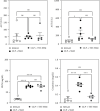Thiostrepton-Nanomedicine, a TLR9 Inhibitor, Attenuates Sepsis-Induced Inflammation in Mice
- PMID: 37662481
- PMCID: PMC10471450
- DOI: 10.1155/2023/4035516
Thiostrepton-Nanomedicine, a TLR9 Inhibitor, Attenuates Sepsis-Induced Inflammation in Mice
Abstract
Sepsis is a life-threatening clinical condition caused by infection and transposition of pathogens and pathogen-associated molecular patterns (PAMPs) into the host bloodstream. During sepsis, activation of toll-like receptors (TLRs) on immune cells triggers the release of pro-inflammatory cytokines and overstimulates the production of vasodilatory mediators such as nitric oxide (NO). These vascular changes lead to widespread inflammation, tissue damage, multiple organ failure, and often death. New therapeutic options are urgently needed. To this end, thiostrepton (TST) has emerged as a candidate for sepsis treatment due to its action as an antibiotic and anti-inflammatory molecule (TLR7-9 inhibitor). Reports in the literature suggest that TLR9 inhibition substantially suppresses the excessive host inflammatory response and attenuates sepsis-induced mortality in the cecal ligation and puncture (CLP) murine model of sepsis. However, to the best of our knowledge, TST has never been directly tested as a therapeutic option for the management of sepsis, possibly due to its low water solubility and drug delivery issues. These facts prompted us to test the central hypothesis that TST encapsulated in phospholipid sterically stabilized micelles (TST-SSM) could be developed into a novel treatment for sepsis. Thus, using our published method of encapsulating the hydrophobic antibiotic TST-SSM, we evaluated the in vivo efficacy of TST-SSM nanomedicine in the murine model of polymicrobial sepsis. We found that TST-SSM increased the median survival of CLP-induced septic mice from 31 to 44 hr by reducing the bacterial burden in the blood and peritoneal lavage. Moreover, plasma levels of pro-inflammatory cytokines (interleukin 6 and tumor necrosis factor-alpha) and NO derivatives were also reduced, whereas renal and hepatic function biomarkers creatinine and aspartate transferase were significantly improved. In conclusion, we identified that TST-SSM nanomedicine has significant potential as a therapeutic agent for sepsis management, primarily due to its anti-inflammatory and antibiotic properties.
Copyright © 2023 K. Esparza et al.
Conflict of interest statement
The authors declare that they have no conflicts of interest.
Figures




References
-
- CDC. Sepsis: data and reports. 2022. https://www.cdc.gov/sepsis/what-is-sepsis.html .
-
- Ward N. S., Levy M. M. Sepsis. In: Ward N. S., Levy M. M., editors. Respiratory Medicine . Cham: Springer International Publishing; 2017.
MeSH terms
Substances
Grants and funding
LinkOut - more resources
Full Text Sources
Medical
Miscellaneous

